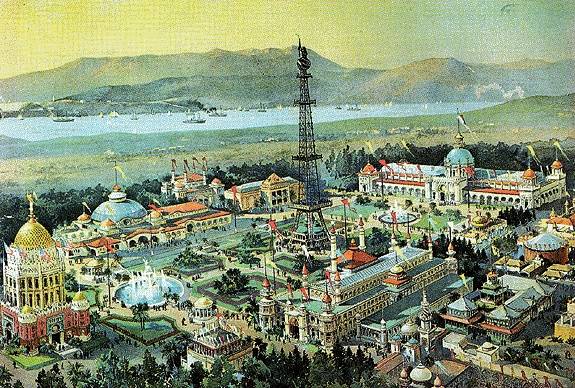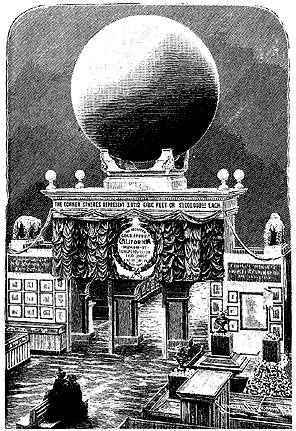Architecture of the Midwinter Fair
Historical Essay
by Gary A. Goss & Walter Biller, San Francisco Examiner
Plan of the 1894 Midwinter Fair.
image: Color lithograph from souvenir postcards.
In July of 1893, plans were solicited by Midwinter Fair leaders for five principal buildings. These buildings were all to be temporary structures of wood-frame construction, with the exception of one permanent brick building. The buildings would exhibit manufactured products and services, agricultural and horticultural industries, mechanical products and the fine arts. A fair administration building completed this list. The Fine Arts Building, being the only permanent building, had to be strictly fire-proof and this explained its brick construction.
After the announcement, a first vision appeared on July 11, 1893 when the San Francisco Examiner illustrated the early Fair plans of architect Leopold Bonet, a designer from the "Great White City"--the 1893 Columbian Exposition held in Chicago. His visions were based on European prototypes and imitated the Chicago fair. Bonet's approach was criticized by many of the leading artists and architects of San Francisco as too foreign a choice for a California exposition. Their stated consensus was the Spanish Renaissance style that was reminiscent of the California missions though their emphasis would evolve dramatically.
Willis Polk stated, "We want to have an exposition excellent of its kind, distinctly Californian in its general ensemble ... it is folly to attempt any comparison with certain of the wonders of the world. We have too long ignored the only pure style of art we can lay any claim to ... the ornate Spanish Renaissance is the only style in any way suitable."
By August 6, 1893 eighteen separate designs by a number of architects were exhibited at the Mills Building. Many of these were hastily drawn within that week. The Spanish Renaissance focus soon lost impetus and Bonet's original ideas were discarded. An eastern element evolved. After a period of public viewing, five eventual designs were chosen by the Fair leaders. The Fair was built by Christmas.
The largest of the five was the 133,000 square-foot Manufactures and Liberal Arts Building located at the present site of the Key monument. The building's architecture could be called "Byzantine Gothic" for its "oriental" exterior. The entrance was in the center of the facade and capped by a radiant blue dome 56 feet in diameter and 130 feet in height. The south side of the building held a continuous arcade illuminated by a ceiling built of no less than 14,000 feet of glass. Exhibits embraced manufactured products, archaeology and progress of labor and invention. Architect: A. Page Brown.
Where the Academy of Sciences and Steinhart Aquarium are located stood the Mechanical Arts Building. This building was of a similar "oriental" style of architecture, with a vaulted pyramidal-roofed entrance of burnished gold flanked by tall minarets. Machinery, mines, transportation, and electricity were the star exhibits of this dignified building. Architect: Edward R. Swain.
The Administration Building, situated at the western end of the Grand Court, behind where today's bandstand is, was a structure in the Moorish style of architecture. The principal feature of this building was its 135-foot dome embellished with a wealth of figures in relief. In its vast interior was a spacious rotunda, with loggia extending through the entire three-storied building. As with the other structures, this building was almost entirely illuminated by natural light. At night hundreds of newly invented incandescent lamps transformed the exterior of the dome into a brilliant globe seen for miles. Architect: A. Page Brown.
Where the M. H. deYoung Museum is today stood the Horticultural and Agricultural Building. The style of architecture described in the Official Guide to the California Midwinter Exposition "was distinctly characteristic of the early Spanish period in California, and in its low yet graceful arches, spreading roof, minor domes and towers, affords an example of all that is most beautiful in the old mission buildings. Indeed it may be considered in this respect as one of the most notable of the Exposition edifices." The structure's enormous glass dome 100 feet in diameter and 90 feet in height was brilliantly lit at night. The building's glass ceilings provided abundant natural light for a variety of plants and flora. Architect: Samuel Newsom.
The fifth of the five main structures was the Fine Arts Building. This building was in the Egyptian style of architecture with a pyramidal entrance flanked by massive columns. The exterior was profusely decorated by Egyptian and Assyrian figures. Sphinxes guarded the steps leading into the gallery. Architect: C.C. McDougall
Central in the Grand Court the Fair's Illuminating focus was the Electric Tower designed by Leopold Bonet. The 266-foot tall iron and steel structure echoed the Eiffel Tower. It was topped by an electric spotlight weighing 6,000 pounds producing a beam of 375 million candlepower. This tremendous lamp was the largest and most powerful constructed up to that time. It was boasted it could provide light to read a newspaper at a dozen miles or more. The Belle Vista Cafe reached by an electric elevator provided dining with a view. Thousands of electric lamps were woven over the entire tower from base to apex forming figures and intricate designs of all patterns.
If you visit Golden Gate Park today you will find some of the architectural legacies of the Fair. These include the Japanese Tea Garden, perhaps the bases of the sphinxes that once guarded the Fine Arts Building, and the stepped concourse, wrapped by a ring of concrete stanchions once linked with chains.
This 20-foot "Gold Sphere" represented all the gold mined in California prior to 1894. Weighing in at 2,071 tons it would have been worth $1,300,000,000.


